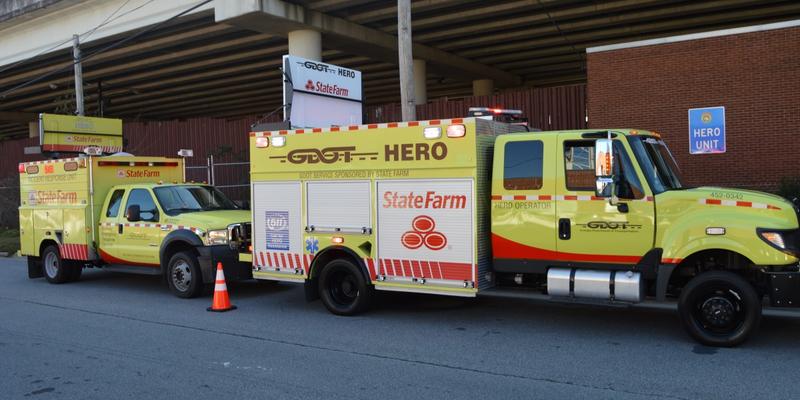On the shoulder lanes of the Georgia interstates, it’s hard to miss the bright yellow-and-orange trucks patrolling the highways and helping stranded motorists.
They’re part of the Georgia Department of Transportation’s Highway Emergency Response Operator (HERO) unit.
But HERO assistant manager Andre Todd said many people confuse them for State Farm insurance trucks.
“They see State Farm, they say, ‘Well, you know what, I don’t have State Farm insurance, but I sure do appreciate it.’ We’re not State Farm, we’re GDOT,” Todd said.
State Farm, which has logos on the trucks, is a sponsor of the program. Since 2009, the insurance company has contributed 20 percent of the HERO program’s $10 million annual operating budget.
Meg Pirkle, chief engineer of GDOT, said she’s proud of HERO’s clearance record, which leads the nation. It averages 30 minutes on large incidents, such as those involving tractor-trailers.
“They have a challenging job to have quick response whenever there is an incident because every minute that lane is blocked, you cause like five minutes of delay downstream,” Pirkle said. “That’s definitely the most bang for the buck when it comes to reducing congestion in Atlanta.”
On a recent chilly morning, Todd wears an orange reflector vest over his khaki HERO uniform. He started work at 4 a.m., and in just four hours, he’s cleared three accidents.
Each operator patrols one of 30 routes across metro Atlanta every day. A route can range from an action-packed four miles on the Downtown Connector to up to 30 miles in more rural areas.
Transportation Management Center
HERO is part of an intricate system that includes police officers, firefighters, 511 citizen calls and hundreds of cameras on the roadways.
The information all comes together at the Transportation Management Center in southeast Atlanta. 
GDOT’s social media specialist Drew Belk explains that 60 percent of all traffic in the state is in metro Atlanta, so that’s where most of the cameras point toward.
“Everyone on the floor has a certain district or certain region, and they monitor cameras to see what’s going on,” Belk said. “Police and state patrol also let us know what’s happening even before we see it.”
They then relay the information to HERO drivers like Andre Todd.
In addition to clearing debris and responding to emergencies, Todd tags abandoned vehicles on the side of the road with green stickers on the rear window.
“Sometimes the police, municipalities, if they’re not sure about this van, what they’ll do is they’ll come up and take a look at the date,” Todd said. “And if it’s been there for two days or so, then they may go ahead and tow it right then.”
First Responders
Todd spent 28 years as the assistant fire chief of DeKalb County.
Jason Josey, who leads the HERO unit, said 90 percent of his staff are former firefighters, police officers or military veterans.
“We’re kind of a hybrid – we’re this first-responder agency who’s a little bit of fire, a little bit of EMT, a little bit of towing, a little bit of police – and because we’re that – we attract people from all of those disciplines,” Josey said.
Josey said the main job of HERO is to respond to emergencies.
“We’re out there 24/7 and because of that, we have to be trained to deal with whatever we run into first,” Josey said. “It’s not always flat tires and people out of gas. We run into major blood and bone trauma incidents, and our men and women have to be able to deal with it when they get to it.”
But unlike an auto club, it’s free when you call 511 and operators help anyone on the Georgia interstates.
“It’s paid for by tax dollars – it’s a free program,” Josey said. “If you’re a citizen of the state of Georgia — heck, if you’re just passing through the state of Georgia — it’s able to help them when they’re in need. It’s also an agency that is there to deal with congestion on the interstate to help make the commutes a little safer, shave time off of it.”
National Recognition
Brad Freeze is director of the Operation Division for Tennessee DOT and is a national expert on traffic incident programs like HERO.
“It’s one of the earliest programs, and it’s certainly one of the best in the country,” Freeze said.
The Federal Highway Administration said there are about 23 traffic incident management programs nationwide, and Georgia is on par with Tennessee and Maryland.
“The HERO program is one of the very best service patrols in the country,” said FHWA spokeswoman Nancy Singer. “The operators receive the highest level of training in comparison with other programs throughout the country.”
She said many states don’t offer full service patrols like Georgia.
The Olympics
In 1972, GDOT had a short-lived program called the Motorists Aid Program. The oil embargo of 1973 resulted in GDOT receiving less money compared to previous years and the program was terminated to cut costs.
In 1994, it was revived as the HERO program after the International Olympic Committee awarded Atlanta the honor of hosting the 1996 Olympic Games.
GDOT’s communications director, Karleen Barron, said after the announcement was made in September 1990, funding became available to build an intelligent transportation system in advance of the 1996 Olympics.
“When the Olympics were coming, we put in all that fiber optics, and we had the additional changeable messages signs and all of that,” Barron said. “So there was a focus on intelligent transportation, on warning motorists to be able to take action before they got to incidents.”
But all this intelligence can’t do anything to control the number of cars on the road. Todd said he wishes drivers would all be more careful.
“Everybody’s in a hurry to get nowhere quick, and they don’t care who they run over to get there,” Todd said.
HERO currently has 88 active operators and plans to expand to 100 by June.



9(MDAxODM0MDY4MDEyMTY4NDA3MzI3YjkzMw004))








